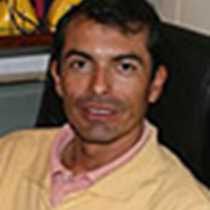Bartolomé & Sullivan Bay
We had an early wakeup call today; as the sun rose we could see the volcanic landscape of Bartolomé Island. This tiny volcanic formation, 0.5 square miles, is located off the east coast of Santiago, the third largest of the Galápagos group. Spatter cones and tuff cones together with the lava flows recreate a quite interesting lunar-looking landscape. Erosion over time has given the island an interesting organic pattern that is very typical of this unique coastline of the Galápagos.
The Galápagos National Park built a staircase that goes all the way to the summit of the highest point of the island. As we walked up the steps, the bare lava flows and the different geological formations transported us back in time when just a few organisms where able to succeed. The lava lizards that live on Bartolomé are among the few animal species so far to have made it here, the smallest of them all due to the very harsh conditions they live in, the heat during the day and with no freshwater makes them one of the strongest creatures of the islands. Pioneer species of vegetation like the Gray mat plant (Tiquilia spp.) or lava cacti are agents of erosion and slowly produce soil. As time goes by, other plants can eventually also be successful colonizers.
We returned to the ship for a well-deserved breakfast and Carlos Romero, our Expedition Leader, gave a snorkeling safety briefing. Right afterward we distributed snorkeling gear to our guests. At around 10:15 we all went to visit the golden beach at Bartolomé where everyone was able to snorkel and get some practice for the next days. It was a beautiful morning.
At noon we returned to National Geographic Islander. A delightful typically Ecuadorean lunch was served, including delicacies such as a suckling pig with potatoes tortillas, “mote pillo” and a variety of deserts, yummy!
In the afternoon we went to visit Sullivan Bay on Santiago or James Island. Sullivan Bay has the bare black basaltic lava flows that were formed around the 1800s and gave us the opportunity to talk about island formation and all its features. The strong rainy season we are going through has increased the food supply and given us a unique opportunity to see the kinds of creatures that inhabit an ecosystem as harsh as this.
The most fantastic recent pahoehoe lava flows at Sullivan Bay were for all of us an interesting way to understand how the very early processes of life take place and how some species have been able to successfully colonize an extremely unfriendly terrain.




